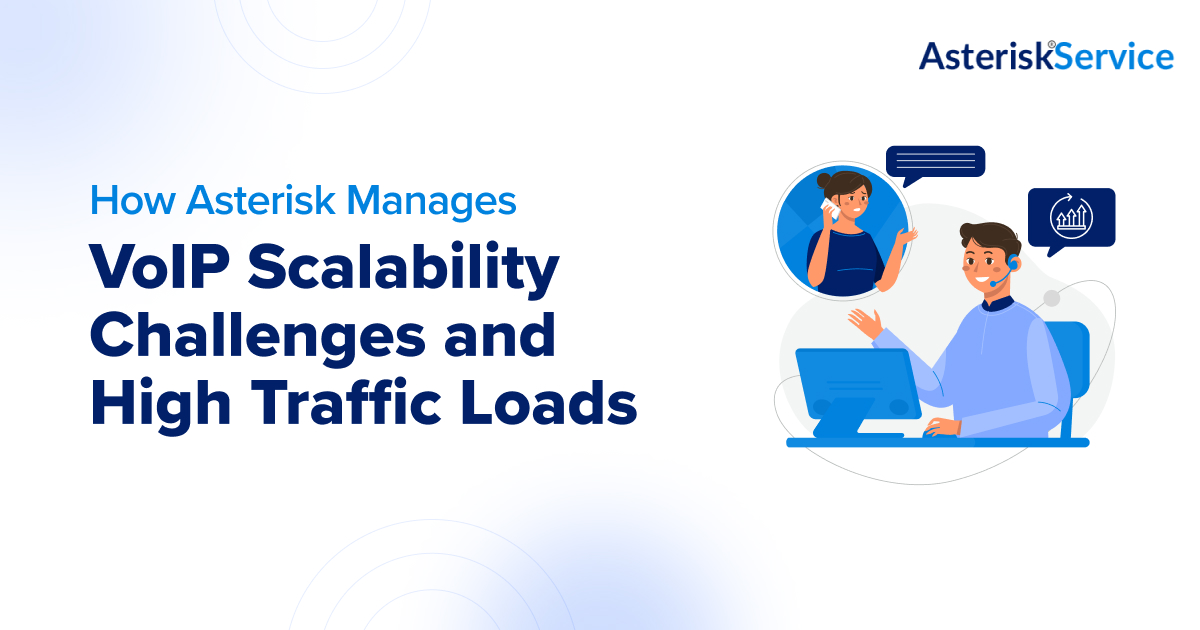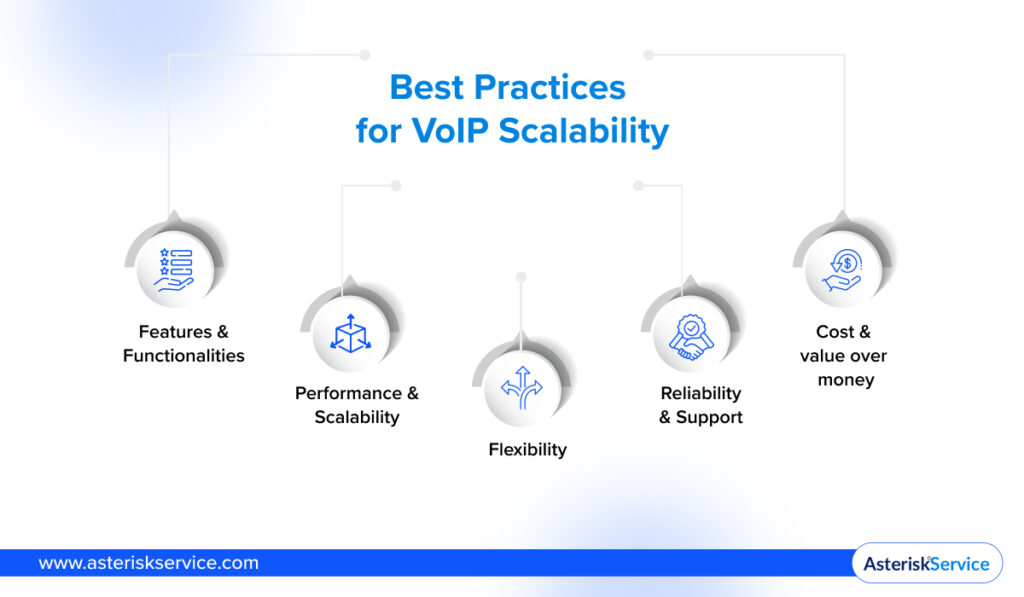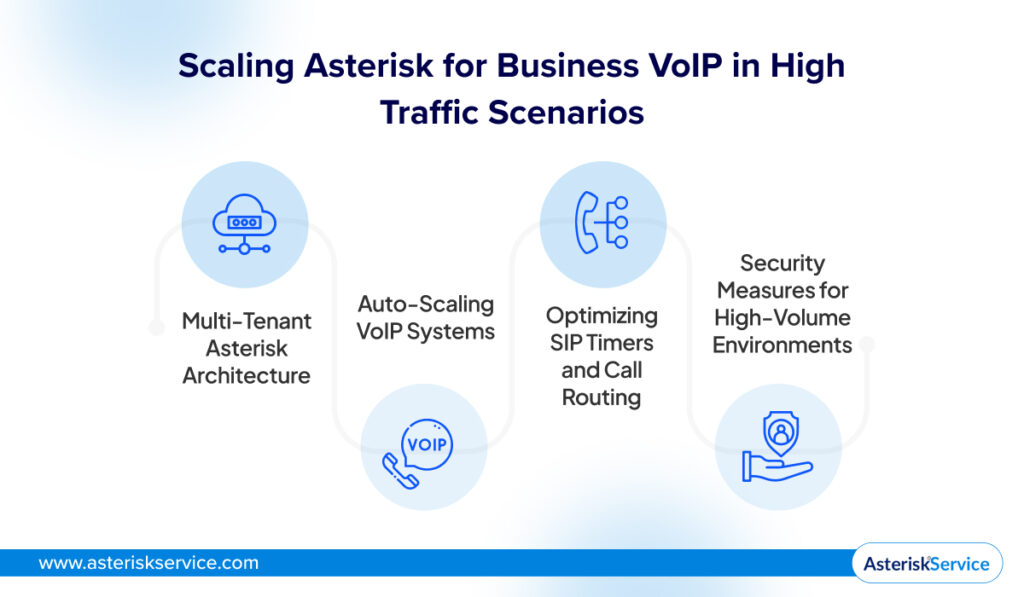
In today’s hyper-connected world, VoIP scalability challenges are a genuine concern, especially for businesses that experience high call traffic. You’re not alone if you’re struggling with keeping your VoIP performance optimal amidst high call volumes. Asterisk, a popular open-source framework for building communications applications, is often lauded for its ability to efficiently handle large-scale VoIP high call volume. But how exactly does it manage this? And what are the potential roadblocks when scaling up your Asterisk call volume capacity?
This blog will explore the nitty-gritty of scaling your VoIP infrastructure with Asterisk. From understanding the challenges of high call traffic to effectively utilizing Asterisk for VoIP load balancing and performance optimization, we’ll delve into strategies to help your VoIP system thrive under pressure.
Understanding VoIP Scalability Challenges
VoIP scalability ensures your system can grow and manage increasing call traffic without performance degradation.
According to research and markets, the global market for VoIP services should grow from $85.2 billion in 2021 to $102.5 billion by 2026, with a compound annual growth rate (CAGR) of 3.8% for the period 2021-2026. The individual VoIP services market should grow from $16.9 billion in 2021 to $19.5 billion by 2026, with a compound annual growth rate (CAGR) of 3.0% for the period 2021-2026.

With the increasing demand for VoIP services, handling a surge in concurrent calls becomes a complex issue. Let’s look at some of the common VoIP scalability challenges.
1. Concurrent Call Limitations
One of the significant challenges faced by businesses is managing concurrent call limitations. The number of simultaneous calls a VoIP system can handle is often dictated by the system’s hardware, network capacity, and software configuration. Call quality can degrade when the system hits its maximum capacity, and new calls may be blocked or dropped.
2. Network Bandwidth Bottlenecks
As call volumes increase, so does the demand for bandwidth. High call traffic can lead to network congestion, impacting call quality with issues like jitter, packet loss, and latency. Optimizing bandwidth usage becomes critical for smooth VoIP performance, especially during peak times.
3. Server Performance and Resource Utilization
High call volumes strain server resources such as CPU, memory, and disk I/O. Optimizing your server and properly allocating resources can lead to faster processing, better call quality, and, in extreme cases, complete server downtime.
4. VoIP Infrastructure Optimization
A scalable VoIP solution requires more than just adding new hardware. Ensuring that all components of your VoIP infrastructure (including software, servers, and networking equipment) are optimized and working cohesively is crucial for high-call volume environments.
Optimizing your server’s performance and resource allocation is also critical, as high call traffic can overwhelm CPU, memory, and disk usage, resulting in slow response times and potential downtime. Finally, for a truly scalable solution, every aspect of your VoIP infrastructure—from hardware to software—must be fine-tuned and work harmoniously to handle high call volumes effectively.
How Asterisk Handles High-Call Volumes
Asterisk’s flexibility and adaptability make it a robust solution for managing VoIP scalability challenges. The platform can handle numerous concurrent calls with proper configurations while maintaining high-quality service. Here’s how Asterisk addresses scalability challenges for VoIP:
1. Asterisk Call Volume Capacity and Performance Optimization
Asterisk call handling capacity is significantly influenced by how well the system is optimized. Several factors contribute to increasing Asterisk’s performance, including:
- Codec Selection: Codecs dictate each call’s bandwidth and processing power. Choosing efficient codecs like G.729 or G.711 can drastically reduce resource consumption, allowing Asterisk to handle more concurrent calls without compromising quality.
- SIP Trunking and Call Routing: Asterisk allows multiple SIP trunks to be configured, effectively distributing the load across different trunks and servers. Properly routing calls helps avoid bottlenecks and enhances overall system reliability.
- Resource Allocation and Load Distribution: Asterisk can handle multiple tasks concurrently, but proper resource allocation is necessary. Configuring dedicated servers for different tasks (e.g., voicemail, IVR, call recording) helps distribute the load effectively.
2. Scaling Horizontally with VoIP Load Balancing
Horizontal scaling is a preferred method to address VoIP’s high call volume. It involves deploying multiple Asterisk servers and distributing the traffic load across them. Use the following techniques to achieve VoIP load balancing with Asterisk:
- SIP Proxy Servers: Tools like Kamailio or OpenSIPS work as a front-end to Asterisk servers, handling SIP signaling and distributing call traffic based on pre-set rules. It allows for better traffic distribution and ensures every server is manageable.
- Distributed Call Processing: Instead of relying on one powerful server, you can deploy a cluster of Asterisk servers, each handling a portion of the call volume. It enhances redundancy and fault tolerance, ensuring that even if one server fails, the others can take over without interruption.
- Automatic Failover Mechanisms: Implementing automatic failover mechanisms ensures that calls are re-routed in case of server failure or overload. This approach helps in scalability and improves the resilience and reliability of your VoIP infrastructure.
3. Optimizing VoIP Infrastructure for High Traffic
Optimizing your VoIP infrastructure is crucial to improve Asterisk’s high call volume management. Here are some best practices:
- Prioritize Traffic with QoS (Quality of Service): By setting QoS policies on your network, you can prioritize VoIP traffic over other data types, reducing latency and ensuring clear call quality even during peak network usage.
- Network Redundancy: Use redundant network security paths and failover internet connections to ensure consistent connectivity. Leveraging SD-WAN (Software-Defined Wide Area Network) for large-scale systems can help optimize traffic flow and prevent call drops due to network issues.
- Session Border Controllers (SBCs): Integrating SBCs into your VoIP infrastructure can help manage high traffic by controlling call sessions, providing security, and facilitating load balancing between multiple Asterisk servers.
Horizontal scaling through VoIP load balancing is critical to further enhance VoIP scalability. Deploying multiple Asterisk servers and balancing call traffic across them using SIP proxies, distributed call processing, and automatic failover mechanisms improves reliability, redundancy, and overall performance.
Asterisk Performance Best Practices for VoIP Scalability

Fine-tuning your Asterisk system is essential to ensure seamless call management and VoIP performance, mainly when dealing with growing call volumes and demand for real-time communication. Let’s explore key strategies to optimize Asterisk for high efficiency and scalability, allowing your business to keep pace with its communication needs.
1. Database Optimization
Database performance is significant in your Asterisk setup if you use databases for CDR (Call Detail Records), call routing, or user authentication. Utilizing a high-performance database such as MySQL or PostgreSQL and optimizing queries can enhance overall system performance.
2. Efficient Logging and Call Recording
High call volumes often mean large logs and call recordings, which can strain the server’s disk I/O. Managing log levels, offloading call recordings to separate storage, and implementing regular maintenance tasks can free up server resources.
3. Upgrading Hardware and Virtualization
Regularly upgrading hardware, such as moving to SSDs for faster I/O operations or adding more CPU cores, can improve the performance of your Asterisk servers. Virtualization technologies like Docker can also help in efficient resource management, allowing you to scale server capacity dynamically as needed.
4. Implementing SIP Compression
SIP compression can significantly lower the data packet size for businesses facing bandwidth constraints, ensuring efficient bandwidth use while maintaining call quality. It is beneficial for remote users or environments with low-bandwidth connections.
Optimizing your Asterisk setup is critical in achieving reliable, scalable VoIP communications. You can significantly enhance system performance by focusing on efficient database management, streamlining logging and call recordings, upgrading hardware, and utilizing SIP compression. Implementing these best practices will help handle high call volumes and ensure your VoIP infrastructure’s long-term stability and reliability, offering clear and uninterrupted communication as your business grows.
Scaling Asterisk for Business VoIP in High Traffic Scenarios
When considering business VoIP for high traffic, several strategies can be employed to optimize Asterisk’s performance:

1. Multi-Tenant Asterisk Architecture
In a multi-tenant setup, each tenant (client or department) has isolated VoIP resources, such as extensions and call routes. This allows for granular control over call handling and ensures that a spike in traffic from one tenant doesn’t affect others.
2. Auto-Scaling VoIP Systems
Auto-scaling solutions can dynamically increase or decrease Asterisk server instances based on real-time traffic loads. Integrating Asterisk with cloud services like AWS or Azure enables automatic resource provisioning, effectively handling peak call volumes without manual intervention.
3. Optimizing SIP Timers and Call Routing
Fine-tuning SIP timers and using the correct call routing logic can enhance Asterisk’s ability to manage call sessions efficiently. Properly configured timers prevent calls from hanging indefinitely and optimize the SIP handshake process.
4. Security Measures for High-Volume Environments
High call volumes can make your Asterisk server a target for VoIP-based attacks like DDoS. Implementing security measures like firewalls, fail2ban, and SIP authentication ensures your system remains secure while handling high traffic.
Successfully managing business VoIP in high-traffic environments requires strategic optimization of your Asterisk setup. Implementing a multi-tenant architecture allows for isolated control of VoIP resources, ensuring balanced call traffic across different clients or departments. Auto-scaling capabilities enable seamless adjustments to server capacity, providing flexibility to meet fluctuating call demands.
Mastering VoIP Scalability with Asterisk
Addressing VoIP scalability challenges is vital for any business that relies on high call traffic. With Asterisk, you have a powerful and flexible solution that can be fine-tuned to manage high call volumes efficiently. By optimizing server resources, implementing load balancing, and enhancing your VoIP infrastructure, Asterisk can scale to meet your business’s growing needs without sacrificing performance or call quality.
Understanding and applying these best practices can overcome scalability hurdles and ensure that your Asterisk high-call volume environment remains robust, secure, and responsive.
If you’re looking for expert assistance in enhancing your VoIP system’s performance and scalability with Asterisk, consider checking out Asterisk Services. We specialize in custom Asterisk development, VoIP optimization, and scalable solutions tailored to your business needs. Contact us to explore how their team of experts can help you create a resilient and efficient VoIP system.
Optimize and scale your VoIP system with Asterisk—because every call matters.
FAQs
Q1: What is the call capacity of an Asterisk server?
Asterisk call handling capacity varies based on hardware specifications, network bandwidth, and system optimizations. Generally, a single Asterisk server can handle hundreds to thousands of concurrent calls when configured correctly.
Q2: How can I optimize Asterisk for high call volumes?
Optimizing codecs, utilizing SIP trunking, implementing load balancing, and improving hardware resources can significantly enhance Asterisk’s performance for high call volumes.
Q3: Is VoIP load balancing with Asterisk necessary?
VoIP load balancing is crucial for distributing call traffic across multiple servers, ensuring efficient resource use, and preventing performance degradation during peak times.
Q4: Can Asterisk be used in a cloud environment for scalability?
Absolutely! Cloud-based deployments with AWS or Azure allow for dynamic resource allocation, auto-scaling, and better fault tolerance for Asterisk VoIP systems.
Q5: How does Asterisk handle VoIP security in high call traffic?
Asterisk uses security measures like SIP authentication, firewalls, and DDoS prevention techniques to secure VoIP traffic. Integrating SBCs further enhances security while managing large-scale traffic effectively.